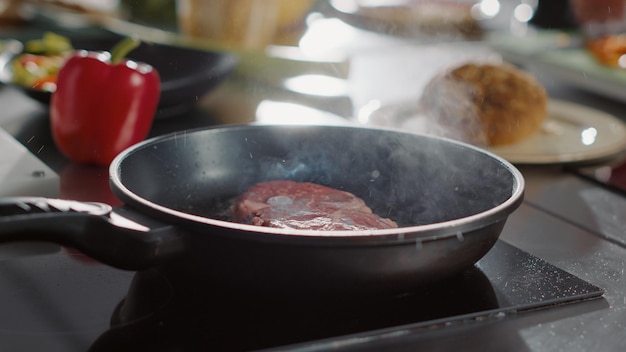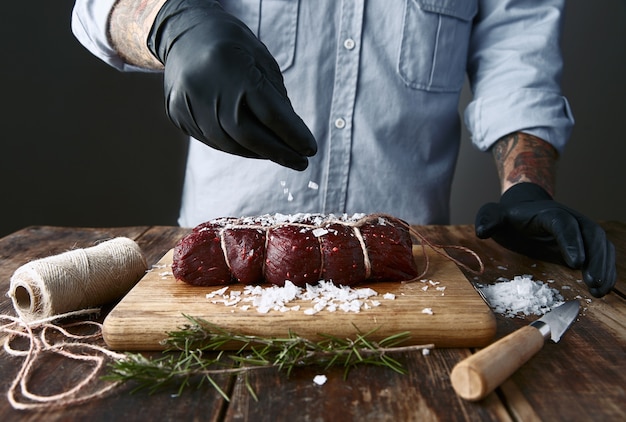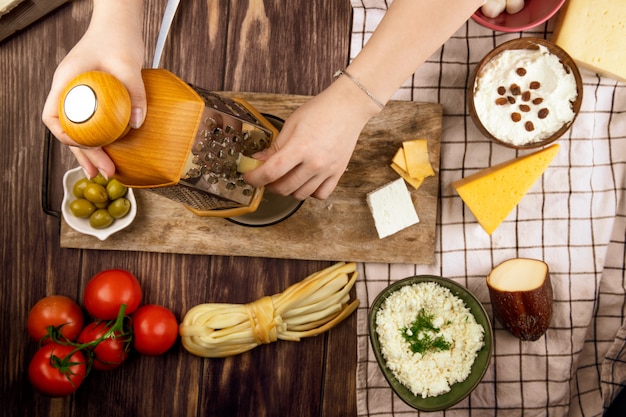Ah, corned beef. The mere mention of those two words conjures up memories of steaming, slow-cooked goodness, often paired with creamy mashed potatoes, tangy sauerkraut, and a generous helping of mustard. It's a dish that's been a staple in kitchens for generations, and for good reason. But getting that perfect, melt-in-your-mouth texture and rich, savory flavour isn't always easy. That's why I'm here, sharing my tried-and-true methods for creating the ultimate corned beef experience.
You see, I've spent years experimenting with different techniques, soaking up tips from seasoned cooks, and even venturing into the world of DIY curing. Through it all, I've come to appreciate the art of slow cooking and the little details that elevate this classic dish to new heights. So, grab your apron, gather your ingredients, and let's embark on this culinary journey together.
(Part 1) Choosing the Right Corned Beef: The Foundation of Flavor

First things first, you need to find a fantastic corned beef. Now, while I've dabbled in the art of curing my own brisket, for this guide, we're keeping it simple and focusing on the pre-brined option. It's readily available, and with a bit of know-how, you can find some absolute gems in your local supermarket.
When selecting your corned beef, think of it like choosing a fine wine – you want the best quality you can afford. Look for a thick, well-marbled brisket with a good fat cap. That fat is crucial; it will render down during cooking, adding incredible flavour and moisture to the meat.
Tips for Picking the Perfect Corned Beef:
Here's a breakdown of what to look for when picking your corned beef:
- Color is Key: A vibrant, deep red colour is a sign of a good corned beef. Avoid anything that looks pale or dull, as this might indicate improper curing or a lower quality cut.
- The Importance of the Fat Cap: A good fat cap is a sign of a well-marbled piece of meat. It signifies richness and tenderness. Think of it as nature's butter, melting away during cooking to create a juicy, flavorful broth.
- Ingredients Matter: Take a look at the label. You want a corned beef that's been cured with minimal ingredients – salt, spices, maybe a touch of sugar. Avoid any corned beef packed with additives or artificial flavours.
- Consider Size and Shape: Choose a corned beef that fits your pot and cooking needs. If you're cooking for a large gathering, you might want a larger piece. Keep in mind that smaller pieces may cook faster.
(Part 2) Preparing the Corned Beef: A Little TLC Before Cooking

Now that you have your beautiful brisket, it's time to give it a little TLC before we start cooking. Traditionally, soaking the corned beef in cold water for a few hours helps remove some of the excess salt. You can definitely do this, but I prefer a more streamlined approach. A good rinse under cold running water, followed by patting it dry with paper towels, is usually sufficient to remove any lingering saltiness.
It's all about personal preference, and if you're concerned about saltiness, feel free to soak it. Just make sure to change the water every hour or so for optimal results.
Optional: Adding Flavor with Aromatics:
Now, I'm a firm believer in enhancing flavours wherever possible. So, before we get to the cooking, I like to give the corned beef a little aromatic massage. It's a simple trick that makes a big difference. I take a handful of freshly cracked black peppercorns and a few bay leaves and gently rub them into the surface of the meat. The aroma of those spices mingling with the corned beef is enough to make your mouth water!
If you're feeling adventurous, you can also add a sprinkle of coriander seeds, a pinch of mustard seeds, or even some dried thyme. Let your culinary creativity shine!
(Part 3) Cooking the Corned Beef: The Slow and Steady Method

Now for the main event! cooking corned beef is all about patience and gentle heat. I'm a firm believer in the slow and steady approach, which yields the most tender and flavorful results. You'll need a large pot, preferably a dutch oven, with enough capacity to comfortably submerge the corned beef.
A Step-by-Step Guide to Cooking the Perfect Corned Beef:
- Start with Cold Water: Place the corned beef in the pot and fill it with cold water, ensuring the meat is completely submerged by at least an inch or two. This is important for even cooking and creating a rich, flavorful broth.
- Bring to a Gentle Simmer: Bring the water to a boil over high heat. Once boiling, reduce the heat to a gentle simmer. The corned beef should be simmering, not boiling, throughout the cooking process. If you notice vigorous bubbling, reduce the heat further.
- Skim Off the Foam: As the corned beef cooks, a layer of foam will likely form on the surface of the broth. This is perfectly normal, but it can cloud the broth. Use a spoon to skim off the foam periodically. It's a small detail, but it helps keep the broth clear and prevents any bitterness from developing.
- Add Flavor Bombs: Now it's time to amplify the flavour with aromatics. For my corned beef, I like to add a generous bouquet of fresh herbs - a mixture of thyme, parsley, and a few sprigs of rosemary. Don't forget a few cloves of garlic for an extra punch of flavour.
- The Magic of Slow Simmering: Cover the pot with a lid and let the corned beef simmer gently for 3-4 hours. The key is to let the heat slowly work its magic, breaking down the tough connective tissues and transforming the meat into a melt-in-your-mouth masterpiece. Check the doneness after 3 hours. If the corned beef still feels slightly tough, continue simmering for another 30-60 minutes.
- Use a meat thermometer: For an extra layer of assurance, use a meat thermometer to ensure the internal temperature of the corned beef reaches 160°F (71°C). This indicates that the meat is cooked through and safe to eat.
Don't Forget the Broth!
While the corned beef takes center stage, let's not forget about the broth. It's more than just leftover liquid; it's a flavorful elixir that can transform any dish. It's packed with deliciousness and can be used to create a hearty soup, add depth to your gravy, or even act as the base for a creamy potato gratin. Don't waste this treasure! Allow the broth to cool slightly, skim off any excess fat, and store it in an airtight container in the refrigerator for later use.
(Part 4) Resting the Corned Beef: A Moment for Relaxation
Now, I know you're probably eager to dive into that beautiful corned beef, but a little rest is crucial. Once the cooking is complete, carefully remove the corned beef from the pot and set it aside on a cutting board. Cover it with a piece of foil to keep it warm and moist. Let it rest for about 15-20 minutes.
This resting period allows the juices to redistribute throughout the meat, making it even more tender and succulent. It also makes slicing much easier. Just picture those perfectly smooth, even slices.
(Part 5) Slicing and Serving the Corned Beef: Unveiling the Flavor
Alright, the moment of truth! After resting, your corned beef is ready to be sliced and enjoyed. Here's the key: always slice against the grain. This means slicing across the muscle fibres, which makes the corned beef easier to chew and results in a more tender texture.
Now, when it comes to serving, the world is your oyster. You can't go wrong with a classic corned beef sandwich on rye bread with mustard and sauerkraut.
Serving Suggestions: A Corned Beef Feast:
But if you're looking to create a real culinary masterpiece, why not go for a traditional Irish feast? It's a celebration of flavors and textures that will leave everyone feeling satisfied. Here's what you'll need:
| Dish | Description |
|---|---|
| Corned Beef | Sliced corned beef, the star of the show! |
| Mashed Potatoes | Creamy, fluffy mashed potatoes, seasoned with butter and a touch of milk, providing a comforting element to the meal. |
| Pickled Cabbage | Tangy and crunchy, pickled cabbage adds a delicious contrast to the rich corned beef. You can find it pre-made in the supermarket or whip up your own batch. |
| Carrots | Tender and sweet, carrots add a lovely pop of color and flavour to the plate. |
| Boiled or Roasted Vegetables | green beans, broccoli, or Brussels sprouts – choose your favorites! They add a fresh and healthy touch to the feast. |
If you're feeling adventurous, try adding some grilled pineapple or a dollop of mango salsa to your corned beef. It brings a delightful sweet and tangy twist to the classic dish.
(Part 6) leftover corned beef: Don't Waste a Bite!
I hate to see good food go to waste, especially when it's as delicious as corned beef. There are so many ways to enjoy it beyond the initial feast.
One of my favorite uses for leftover corned beef is a hearty, flavorful corned beef hash. Fry up some diced potatoes with onions and peppers, then add some shredded corned beef and a splash of the leftover broth. It's a comforting and satisfying meal that will remind you of the original feast.
Other Leftover Ideas:
Here are a few more ideas to make the most of your leftover corned beef:
- Corned Beef and Cabbage Soup: Combine some leftover corned beef and cabbage with chicken broth and your favorite vegetables for a hearty, warming soup.
- Corned Beef Quesadillas: Add shredded corned beef to your quesadilla filling for a delicious and unexpected twist on a classic.
- Corned Beef and potato salad: Incorporate diced corned beef into your potato salad for a boost of flavor and protein.
- Corned Beef Pitas: Fill a pita bread with shredded corned beef, hummus, and fresh vegetables for a quick and easy lunch.
- corned beef tacos: Embrace a fusion of flavors with corned beef tacos. Shred the corned beef, add your favorite toppings, and enjoy!
(Part 7) Tips for Success: Elevate Your Corned Beef Game
Here are a few little tips and tricks I've picked up over the years to ensure your corned beef turns out absolutely perfect:
- Don't Overcook It: Overcooking corned beef can lead to dryness and toughness. Use a meat thermometer to ensure the internal temperature reaches 160°F (71°C). If you're unsure, it's better to err on the side of undercooking, as you can always cook it a bit longer if needed.
- Embrace Experimentation: Feel free to add your own personal touch to your corned beef. Experiment with different spices, herbs, and vegetables to create your own signature recipe. You might discover your new favorite way to enjoy this classic dish.
- Make it a Family Affair: Cooking corned beef is a wonderful way to involve the whole family. Have the kids help with chopping vegetables, stirring the broth, or setting the table. It's a fun and rewarding experience for everyone.
- Save the Broth: The broth is a delicious treasure, so don't throw it away! It's the perfect base for soups, stews, and even gravy. You can also freeze it for later use.
(Part 8) FAQs: Your Corned Beef Questions Answered
I'm often asked about corned beef, so I thought I'd address a few common questions here.
1. Can I use a slow cooker for corned beef?
Absolutely! A slow cooker is an excellent option for corned beef. Place the corned beef in the slow cooker, add enough water to cover it, and cook on low for 8-10 hours, or on high for 4-6 hours. You can also add your favorite aromatics to the slow cooker.
2. Can I use a pressure cooker for corned beef?
Yes, you can! A pressure cooker can significantly reduce cooking time. Place the corned beef in the pressure cooker, add enough water to cover it, and cook for 90-120 minutes at high pressure. Be sure to follow the manufacturer's instructions for your specific pressure cooker.
3. How do I store leftover corned beef?
Store leftover corned beef in an airtight container in the refrigerator for up to 4 days. You can also freeze leftover corned beef for up to 3 months. Just be sure to thaw it in the refrigerator before using.
4. Is corned beef healthy?
Corned beef is a good source of protein and iron. However, it's also high in sodium, so it's best to enjoy it in moderation. If you're concerned about sodium, you can soak the corned beef in cold water for a few hours before cooking to remove some of the excess salt.
5. What are some alternative recipes for corned beef?
Beyond the classic corned beef and cabbage, there are many ways to enjoy this delicious meat. You can try corned beef hash, corned beef stew, corned beef sandwiches with different toppings, or even corned beef tacos.
I hope this guide has given you the confidence to create the perfect corned beef. Remember, cooking is all about having fun and experimenting. Don't be afraid to try new things and adapt the recipe to your own taste. Enjoy the process, savor the flavors, and create some wonderful memories around the table.
Everyone is watching

Prime Rib Roast Cooking Time Chart: Per Pound Guide
Cooking TipsPrime rib roast. Just the name conjures images of lavish dinners, crackling fires, and hearty laughter. It’s ...

How Long to Bake Potatoes in the Oven (Perfect Every Time)
Cooking TipsBaked potatoes are a staple in my kitchen. They're incredibly versatile, delicious, and surprisingly easy to m...

Perfect Rice Every Time: The Ultimate Guide to Cooking Rice
Cooking TipsAs a self-proclaimed foodie, I've always been a bit obsessed with rice. It's the foundation of countless cuisi...

The Ultimate Guide to Cooking Asparagus: Tips, Techniques, and Recipes
Cooking TipsAsparagus. The mere mention of this spring delicacy conjures up images of vibrant green spears, crisp and burs...

Ultimate Guide to Cooking the Perfect Thanksgiving Turkey
Cooking TipsThanksgiving. Just the word conjures up images of overflowing tables laden with delicious food, the scent of r...
